''Plasma Crystal''
Latest News!
|
September 2009
|
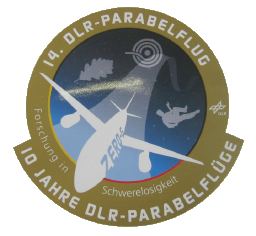







(Pictures courtesy of M. Kretschmer.
Click to enlarge.)
|
10 years of DLR parabolic flights: MPE takes part
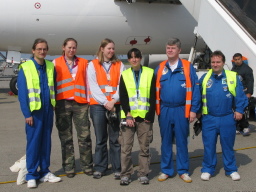 The German Aerospace Center (DLR) celebrates 10 years of microgravity
research onboard the Airbus A300 ZERO-G with its 14th parabolic flight
campaign taking place in Cologne. The MPE takes part in this campaign,
like already in
1999, with a complex plasma experiment conducted by
U. Konopka, L. Wörner, M. Schwabe, Ch. Knapek, A. Lipaev
(IHED/JIHT, Moscow), M. Kretschmer (see picture to the right), and G.
Wildgruber (not in the picture).
This campaign is situated at the airport Cologne (Köln-Bonn) for the
forth time, adjacent to the DLR research center in Köln-Porz, and
not in Bordeaux as usual where the aircraft is based.
In an empty cargo building the scientists and engineers had two weeks time
for the preparation of their experiments and to integrate them into the
aircraft. The experiments were performed on three flight days.
The German Aerospace Center (DLR) celebrates 10 years of microgravity
research onboard the Airbus A300 ZERO-G with its 14th parabolic flight
campaign taking place in Cologne. The MPE takes part in this campaign,
like already in
1999, with a complex plasma experiment conducted by
U. Konopka, L. Wörner, M. Schwabe, Ch. Knapek, A. Lipaev
(IHED/JIHT, Moscow), M. Kretschmer (see picture to the right), and G.
Wildgruber (not in the picture).
This campaign is situated at the airport Cologne (Köln-Bonn) for the
forth time, adjacent to the DLR research center in Köln-Porz, and
not in Bordeaux as usual where the aircraft is based.
In an empty cargo building the scientists and engineers had two weeks time
for the preparation of their experiments and to integrate them into the
aircraft. The experiments were performed on three flight days.
The staff members of the MPE department ''Theory & Complex Plasmas''
tested a totally new plasma chamber, the so-called ''Zyflex'' chamber
for the ''PlasmaLab'' project. This is a cylindrical high frequency
plasma chamber with flexible geometry where e.g. the distance of
the electrodes can be variied with integrated motors. The goal of
''PlasmaLab'' that is to follow the successful plasma experiment facilities
''PKE-Nefedov'' and ''PK-3 Plus'' onboard the International Space Station
ISS is to expand the parameter range where complex plasmas can be studied
in microgravity. More accurate and totally new results can be expected.
The predecessors of ''PlasmaLab'' (''PK-3 Plus'' and ''PK-4'', amongst others)
have also been tested intensively on parabolic flights where each parabolic
flight maneouver provides 20 seconds of weightlessness. ''PK-4'' is to be
launched to the space station in 2011 and operated inside the European
Columbus module. So, MPE personnel gained many years of experience in
participation in parabolic flights. This time, two of them (Konopka,
Kretschmer) were honoured with a bronze medal by Novespace, the aircraft
owning company, for having completed more than 500 and 600, respectively,
parabolas.
In addition to the usual three flight days with 31 parabolas MPE scientists
were offered more flight opportunities on the two ''VIP'' campaign flight
days with 10 parabolas each. Amongst other ''VIPs'' the German astronaut
Thomas Reiter flew again into weightlessness. Reiter (51) spent several
months onboard the Russian space station MIR and stayed onboard the ISS
from July to December 2006 where he also operated our plasma crystal
experiment twice. During the DLR parabolic flight campaign Thomas Reiter
enjoyed operating MPE's next-generation plasma crystal experiment onboard
the A300 ZERO-G.
On September 20 DLR organized an open aero-space day (''Tag der Luft- und
Raumfahrt'') in the research center in Köln-Porz where 100,000
visitors took great interest in the research activities of DLR.
Besides several research aircraft of DLR the Airbus A300 ZERO-G was
on exhibition and MPE members informed the public about the plasma crystal
experiment.
Captions (see left side, from top left to bottom):
The Airbus A300 ZERO-G arrives from Bordeaux in Cologne;
PlasmaLab installed inside the Airbus; Open plasma chamber; Plasma chambe
with mesh electrode; Thomas Reiter operates the PlasmaLab experiment;
Airbus in the morning; Visitors line up the see the A300 and PlasmaLab
on DLR's open day.
More links (external and mostly in German):
DLR:
14th DLR Parabolic Flight Campaign: List of Experiments, September 2009
DLR:
More than 100,000 visitors at the DLR Open Day 2009
WDR:
Schweben für die Wissenschaft
|
June 2009
|

Cover page of ''Physical Review Letters'', Vol. 102, No.25 from
26 June 2009
(Enlarge)
|
Cover page of renowned journal ''Physical Review Letters'' from MPE
The cover of 26 June 2009 issue of the widespread journal ''Physical Review
Letters'' shows a picture of an experiment conducted at the complex plasma
group of the Max Planck Institute for extraterrestrial Physics by Mierk Schwabe.
It depicts a microparticle droplet, which is formed in a complex plasma.
Such a plasma consists of an ionized gas into which small charged particles
- the microparticles - are inserted. Usually the particles are pulled to the
lower part of the plasma inside the experimental chamber by gravity.
If the bottom plate of the chamber is heated, they are lifted into the central
part of the plasma. The resulting force compensates for gravity acting on the
particles. The complex plasma then looks similar to those produced in
analogous experiments with ''PK-3 Plus'', MPE's plasma lab in weightlessness
onboard the International Space Station ISS. A central, particle free region
is especially noticeable - the void.
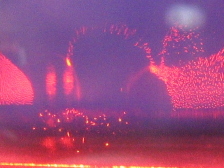 Under certain conditions novel phenomena appear at the lower boundary of this
void under gravity conditions: Bubbles form, which ''explode'' upwards into the
void, like shown on the picture to the right
(Enlarge. Courtesy of M. Kretschmer).
Droplets or blobs such as the one shown on the cover appear, ejecting particles
into the void. Another phenomenon is the formation of cusps in the particle
cloud, which are pointing upwards. These cones remind of so-called ''Taylor cones'',
which form in liquids under the influence of electric fields and surface tension.
Under certain conditions novel phenomena appear at the lower boundary of this
void under gravity conditions: Bubbles form, which ''explode'' upwards into the
void, like shown on the picture to the right
(Enlarge. Courtesy of M. Kretschmer).
Droplets or blobs such as the one shown on the cover appear, ejecting particles
into the void. Another phenomenon is the formation of cusps in the particle
cloud, which are pointing upwards. These cones remind of so-called ''Taylor cones'',
which form in liquids under the influence of electric fields and surface tension.
The picture on the cover demonstrates that the blobs were completely independent
from the rest of the particle cloud. The illustration results from a tomographic
procedure in which the droplet is recorded in vertical cuts that are later
combined to a three-dimensional image.
Even though the droplets and bubbles contain only a few hundreds of particles,
they demonstrate many effects typical for fluids. The particles inside the blobs
move in vortices like in the case of water drops in an air stream, and there is
evidence of surface tension. In contrast to water molecules, in complex plasmas
the individual particles can be directly observed and examined. This makes complex
plasmas the ideal model system for the dynamical analysis of such phenomena.
Reference: M. Schwabe, M. Rubin-Zuzic, S. Zhdanov, A. V. Ivlev, H. M. Thomas,
and G. E. Morfill. Formation of Bubbles, Blobs, and Surface Cusps in
Complex Plasmas, Physical Review Letters 102, 255005 (2009)
|
February 2009
|
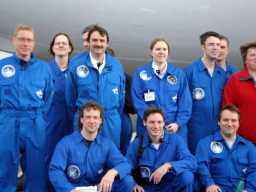
MPE parabolic flight team, front: Christian Deysenroth, Sebastian
Albrecht, Michael Kretschmer. 2nd row: Markus Thoma, Hubertus Thomas,
Mierk Schwabe. Not on picture: Tanja Hagl, Ralf Heidemann, Christian Rau.
Picture courtesy of M. Schwabe (Enlarge)
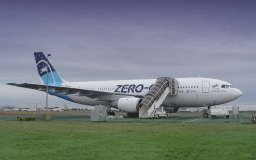
Airbus A300 Zero-G at Bordeaux airport.
Courtesy of M. Kretschmer (Enlarge)
|
DLR parabolic flight campaign #13: MPE contributes twice
On February 2 - 12 the 13th parabolic flight campaign organized by the German
Aerospace Center (DLR) takes place in Bordeaux, France. And two of the
selected experiments are proposed by the MPE:
PK-4 und FAST PK-3 Plus.
PK-4 is the follow-up laboratory of the successful PK-3 Plus complex plasma
facility that is onboard the International Space Station ISS since 2006.
It is planned to be launched to the ISS in 2011 where it will be operated
in the European "Columbus" module. PK-4 is designed to study complex plasmas
in microgravity mainly in the fluid phase. At the time being the project is
in phase c/d (supported by the European Space Agency ESA) which should lead
to the first 1:1-model of the flight hardware. To check the microgravity
capability of the components being built in several parabolic flight campaigns
are necessary. Also scientific questions which can be answered in the 20 seconds
duration of weightlessness in a parabola are planned.
During one campaign 93 parabolas on 3 flight days are performed which leads
to a cumulative zero-g time of 30 minutes. With PK-4 - on its 7th parabolic
flight campaign - optimized gas jet dispensers are tested and self-organization
effects in complex plasma fluids (so-called 'lane formation') are studied at
this time.
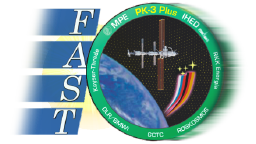 Unlike PK-4, FAST PK-3 Plus (mission patch on right side;
enlarge)
makes its debut on this parabolic flight campaign.
This experiment is based on the high frequency plasma chamber of PK-3 Plus,
but in contrast to the ISS facility it is equipped with a fast video data
acquisition system that allows the recording of images with 1 Mpixel resolution
with 1000 frames per second. The big advantage of complex plasmas - that is to
be able to simulate and observe condensed matter on individual particle ("atomic") level -
can be exploited also for fast processes such as the transition of shock waves.
The data acquisition system consists of a fast camera and a storage system made
up by 24 hard disk drives which allow the recording of 30 minutes with the high
frame rate. This sub-system alone weights around 75 kg which is as heavy as the whole
facility in space. On parabolic flights with the Airbus A300 Zero-G plane the
restrictions are less. Now the whole setup weights 370 kg which is quite normal
for this kind of experiment.
Unlike PK-4, FAST PK-3 Plus (mission patch on right side;
enlarge)
makes its debut on this parabolic flight campaign.
This experiment is based on the high frequency plasma chamber of PK-3 Plus,
but in contrast to the ISS facility it is equipped with a fast video data
acquisition system that allows the recording of images with 1 Mpixel resolution
with 1000 frames per second. The big advantage of complex plasmas - that is to
be able to simulate and observe condensed matter on individual particle ("atomic") level -
can be exploited also for fast processes such as the transition of shock waves.
The data acquisition system consists of a fast camera and a storage system made
up by 24 hard disk drives which allow the recording of 30 minutes with the high
frame rate. This sub-system alone weights around 75 kg which is as heavy as the whole
facility in space. On parabolic flights with the Airbus A300 Zero-G plane the
restrictions are less. Now the whole setup weights 370 kg which is quite normal
for this kind of experiment.
During this parabolic flight campaign some PK-3 Plus experiments already performed
onboard the ISS are repeated, but now with much higher visual and temporal resolution,
for example, shock waves, self-excited waves, so-called 'string fluids' and
'thermophoretic bubbles'. The high speed recording allows also quick scans through
the microparticles inside the plasma, so that we can even gain 3-dimensional
information in liquid systems.
As usual the team stays 12 days in Bordeaux for setup integration, testing
and the flight days.
Again, our colleague Mierk Schwabe reports about the latest developments
in Bordeaux and her first parabolic flight in her
 blog.
('Wrap-up') (German only) blog.
('Wrap-up') (German only)
Marginal note: MPE staff member Michael Kretschmer, participating in parabolic
flights since 2001, reaches his 500th parabola during this campaign.
This is rewarded by the organizing company Novespace with a bronze medal.
|
January 2009
|

PK-3 Plus 10th Mission Logo
(Enlarge) ©MPE/MK
|
3 years of PK-3 Plus: 10th Mission on ISS
In January MPE staff members visit the space control center in Moscow to
conduct the 10th mission with the complex plasma experiment
PK-3 Plus onboard the International Space Station ISS. Russian
cosmonaut Yury Lonchakov - flight engineer of the 'Expedition 18' crew -
will be available for our experiment on three days for 90 minutes each day.
PK-3 Plus is onboard the ISS since December 2005 and was operated for
the first time in January 2006. So the 10th mission also marks
the 3rd anniversary of this plasma facility in the microgravity
environment of
the space station. PK-3 Plus continues the successful story of the
previous plasma laboratory PKE-Nefedov that was in orbit from
2001 until 2005 and was operated 13 times, making it one of the most used
experiment facilities on the ISS.
This time experiments of crystallization, 'string fluids' and 'bubbles'
are on the list. Bubbles inside a thermophoretic complex plasma were
first discovered in the MPE in 2006 [1].
As in the former mission our colleague
Mierk Schwabe will report in her
 Blog about the latest events in Moscow. (German only!) Blog about the latest events in Moscow. (German only!)
[1] M. Schwabe, et al: ''Formation of bubbles, blobs and surface cusps in fluid
complex plasmas''. Submitted to Physical Review Letters, Dec. 2008
|
Updated: 2010-02-02
Contact: Michael Kretschmer

|